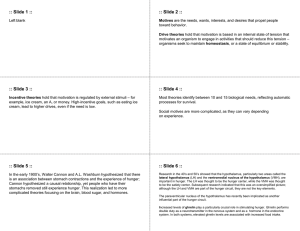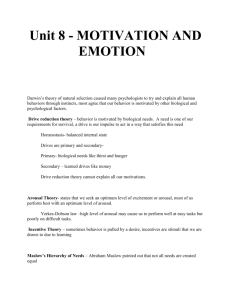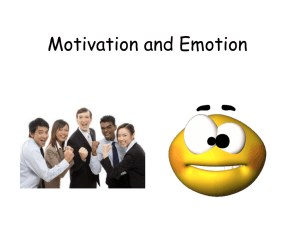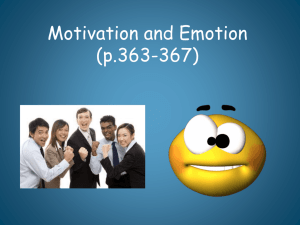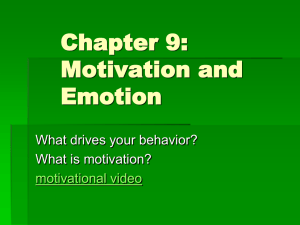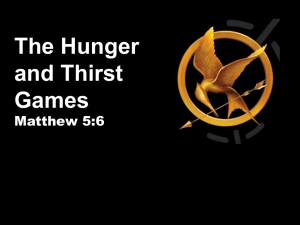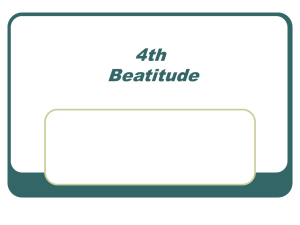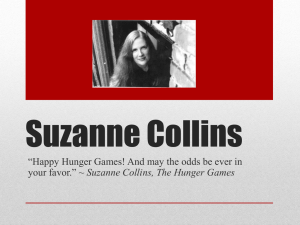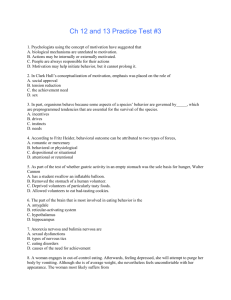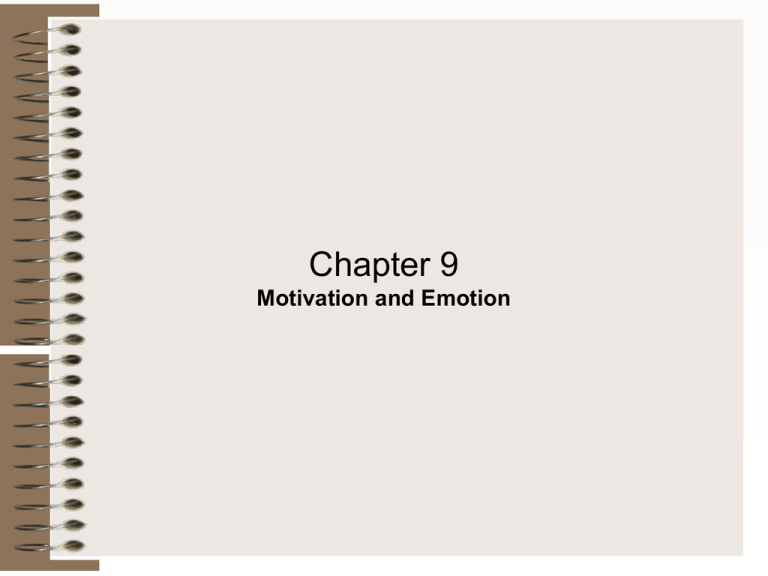
Chapter 9
Motivation and Emotion
Defining Motivation
• Motivation involves goal-directed behavior
(intentional, not random)
• There are a number of different theories that
attempt to explain goal-directed behavior.
– Drive theories emphasize the importance of
reducing physiological tension as a motivator
of behavior (think “we eat because we feel
hungry”)
– Incentive theories emphasize the importance
of external reward in motivation behaviors.
– Evolutionary theories assert that human
motives are products of evolutionary
processes.
The Motivation of Hunger and Eating: Biological Factors
• In the early 1900’s, 1 (Full name) and Washburn
hypothesized that there is an association between 2 (2
words) and the experience of 3 ; However we know now that
people who have their stomachs removed still experience
hunger. This realization led to more complicated theories
focusing on the brain, 4 (3 words) and digestive factors,
and hormones.
• Research in the 40’s and 50’s showed that the hypothalamus,
particularly two areas called the 5 (2 words) (LH) and the 6
(2 words) of the hypothalamus (VMH), are important in
hunger. The LH was thought to be the “ 7 center”, while the
VMH was thought to control the ability to recognize 8
(fullness). Subsequent research indicated that the “dual
centered model” was an oversimplified picture, although the
LH and VMH are part of the hunger circuit, they are not the
key elements.
• The 9 nucleus of the hypothalamus has recently been
implicated as another influential part of the hunger circuit.
The Motivation of Hunger and Eating: Biological Factors 2
• Other research has focused on the role of blood glucose and
digestive regulation on hunger. Manipulations that 10 when
blood glucose level can 11 hunger (and vice versa).
• 12 (name) theory proposed that fluctuations in blood
glucose level are monitored in the brain by 13 – neurons
sensitive to glucose in the surrounding fluid. It appears likely
that hunger is regulated , in part, through glucostatic
mechanisms.
• Hormones circulating in the blood also appear to be related
to hunger. Insulin, secreted by the pancreas, must be
present for cells to use blood glucose. Normal secretion of
insulin is associated with 14 hunger. The mere sight and 15
of food has been shown to increase 16 secretion.
• Recently, a “new” hormone, 17 , has been discovered to be
released from fat cells into the bloodstream. Leptin provides
the hypothalamus with information about the body’s 18
stores in the body. When fat stores are high feeling of
hunger diminish.
The Motivation of Hunger and Eating: Environmental Factors
• Clearly, hunger is related to biology; however, it is also regulated
by environmental factors like: (1) the availability/ palatability of
food; (2) 19 (2 words) & habits; and (3) stress.
• Hunger can also be triggered by exposure to environmental cues
that have been associated with 20 .(such as appearance or odor
of food, effort required to eat a particular food, etc). Research
shows that these external cues influence eating behavior to
some extent, beyond biological hunger.
• Observational learning appears to play a part in what we like to
eat. To a large degree food preferences are a matter of 21 .
Studies show that people like foods that are familiar to them.
(Even, dog meat is a delicacy in some parts of the world!)
Learning also appears to influence when and how much people
eat.
• Finally, studies have show that 22 (arousal) leads to 23 eating
with many people. Some research suggests that stress induced
eating is especially common among 24 dieters.
The Human Sexual Response
•
•
•
•
•
William Masters and Virginia Johnson conducted groundbreaking
research in the 1960s using 25 recording devices to monitor the 26
changes of volunteers engaging in sexual activity. They outlined 27 (#)
stages in the sexual response cycle.
The excitement phase is the initial arousal, which escalates rapidly.
Muscle tension, respiration rate, heart rate and blood pressure 28
quickly. Also 29 , the engorgement of blood vessels occurs in the
genitals, occurs.
The plateau phase occurs when physiological arousal continues to
build, but at a 30 pace.
The orgasm phase occurs when sexual arousal reaches its peak
intensity and is discharged in a series of muscular contractions that
pulsate through the 31 area. The subjective experience of orgasm is
very similar for men and women, although women can more than 32
orgasm in a brief period of time. On the other hand, they are more likely
to engage in intercourse without experiencing an orgasm.
The resolution phase is characterized by sexual arousal that gradually
33 . Men experience a refractory period after orgasm, when they are
largely 34 to further stimulation. This may last from a few minutes to a
few hours and 35 with age.
The Mystery of Sexual Orientation
•
36 (2 words) refers to a person’s preference for emotional and sexual
relationships with individuals of the same sex (homosexuality), the other sex
(heterosexuality), or either sex (bisexuality).
•
Kinsey and others have concluded that homosexuality and heterosexuality are
37 (2 words) on a continuum.
•
Data on the prevalence of homosexuality suggests that 38 ( # range)% of the
population could reasonably characterized as homosexual.
•
Many environmental theories explaining homosexuality have been put forth
historically.
– Freud held that a person must identify with a strong same sexed parent or a
homosexual orientation may develop.
–
39 theorists assert that homosexuality is a learned preference acquired
when same-sex stimuli hve been paired with sexual arousal (learned through
conditioning.)
–
Extensive research have 40 to support either theory.
– What has been found is that most men and women with homosexual
orientations can trace their leanings back to early childhood, suggesting that
the roots of homosexuality are more 41 than environmental.
Motivation
• 42 motivation involves the need to excel, especially in
competition with others. This motive involves the need to
master _43_ challenges and meet 44 standards of
excellence.
• People who are relatively high in the need for achievement
work harder and more persistently, they tend to 45
gratification well and to pursue competitive careers.
• Achievement (and affiliative) motivational needs are generally
measured using the 46 (3 words), a projective test which
requires a subject to write or tell stories about what is
happening in pictures of people in ambiguous scenes.
• 47 factors have been shown to influence achievement
strivings, causing it to increase when the probability of
success and the incentive value of success are high. When
the probability and incentive values are weighed together, 48
challenging tasks seem to offer the best value.
The Elements of Emotional Experience
•
•
•
•
The 49 component of emotion involves subjective conscious
experience that have an evaluative aspect…people’s 50 appraisals
of events are key determinants in emotional experience.
Much of the physiological arousal associated with emotion occurs
through the actions of the 51 nervous system. This nervous system
is responsible for the highly emotional 52 -or-flight response. The
involuntary nature of autonomic response is the reason that measures
of autonomic activity like the GSR ( 53 (3 words)) or polygraph can
be used to detect whether someone is uncomfortable with what they
are telling you (although polygraph measures are not all that
accurate).
In the brain, the limbic system is the emotional “neural circuit”, with a
particularly central role played by a structure called the 54 .
Behaviorally, emotions are expressed through body language and
facial expressions. Research indicates considerable cross-cultural
similarities in the ability to differentiate facial expressions of emotion.
Cross-cultural similarities have also been found in the cognitive and
behavioral components, although display rules, or norms for
regulating appropriate expression of emotion vary from culture to
culture.
Theories of Emotion
• The 55(2 words) theory of emotion holds that you see a
snake, your pulse races, and you feel afraid because your
pulse is racing (emphasis on the physiological determinants of
emotion).
• The 56 (2 words) theory holds that you see a snake, the
information is sent to the thalamus, which relays the signals
simultaneously to the cortex and to the autonomic nervous
system.
• According to Schacter & Singer, the experiences of emotion
depends on 57 (2 words) first, then the cognitive 58 of that
arousal.
• Darwin viewed emotions as a product of 59 that evolved
because they had 60 value.
• Evolutionary theories of emotion assume that emotions are
61 reactions that require little cognitive interpretation. Robert
Plutchik (1984, 1993) has devised a model of how primary
emotions blend together to form secondary emotions.
Happiness
• Research on happiness indicates that commonsense
notions about what makes people happy are largely
incorrect.
• Income (money), 62 , parenthood, intelligence, and
attractiveness are largely uncorrelated with happiness
(do not predict).
• Physical health, good social relationships and , 63 ,
are modestly correlated with happiness.
• Love, marriage, work satisfaction, and 64 are the
only factors shown to be strongly predictive of
happiness.
• Research indicates that 65 feelings rather than 66
reality is what is important in deciding happiness.

